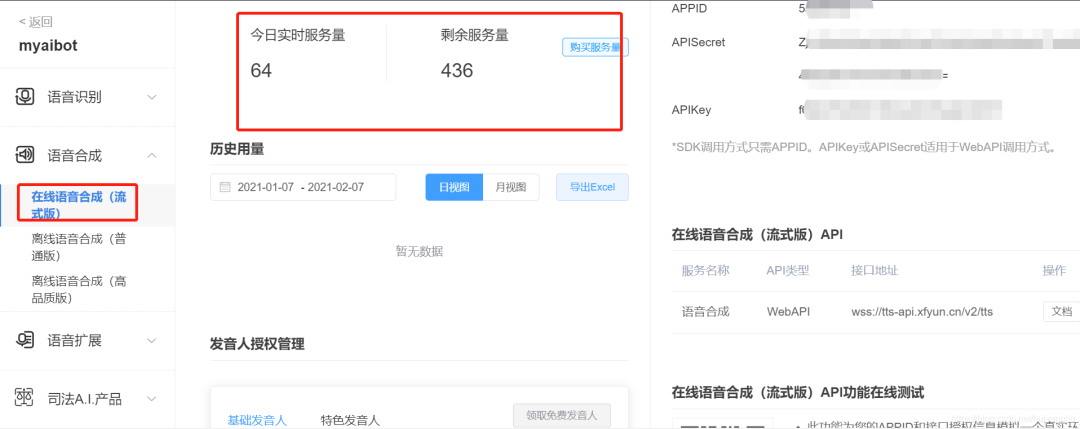利用 Python 打造一个语音合成系统

背景

语音合成系统

准备工作
Anaconda Python 3.7 visual studio code

步骤

创建好了之后,点击该应用进入,有该应用的详细栏目。
点击左侧的语音合成,再到下一级在线语音合成(流式版)
APPID APISecret APIKey

代码实现
pip install websocket-clientpip install playsound
class play:def __init__(self): #初始化函数def play_sound(self):#播放音频函数def select_vcn(self,*arg):#选择下拉框设置发音人def xfyun_tts(self):#进行语音合成
def __init__(self):self.APP_ID = 'xxx' #请填上自己的appidself.API_KEY = 'xxx' #请填上自己的appkeyself.SECRET_KEY = 'xxx' #请填上自己的appsecretself.root=tk.Tk() #初始化窗口self.root.title("语音合成系统") #窗口名称self.root.geometry("600x550") #设置窗口大小self.root.resizable(0,0)#self.root.resizable(width=True,height=True)#设置窗口是否可变,宽不可变,高可变,默认为Trueself.lb=tk.Label(self.root,text='请选择语音发音人')#标签self.tt=tk.Text(self.root,width=77,height=30) #多行文本框self.cb=ttk.Combobox(self.root, width=12) #下拉列表框#设置下拉列表框的内容self.cb['values']=("甜美女声-小燕","亲切男声-许久","知性女声-小萍", "可爱童声-许小宝","亲切女声-小婧")self.cb.current(0) #将当前选择状态置为0,也就是第一项self.cb.bind("<<ComboboxSelected>>", self.select_vcn)self.tk_tts_file=tk.Label(self.root,text='生成文件名')self.b1=tk.Button(self.root, text='进行语音合成', width=10,height=1,command=self.xfyun_tts) #按钮self.tk_play=tk.Button(self.root, text='播放', width=10,height=1,command=self.play_sound) #按钮#各个组件的位置self.tk_tts_file.place(x=30,y=500)self.b1.place(x=300,y=500)self.tk_play.place(x=400,y=500)self.lb.place(x=30,y=30)self.cb.place(x=154,y=30)self.tt.place(x=30,y=60)self.root.mainloop()
def select_vcn(self,*arg):if self.cb.get()=='甜美女声-小燕':self.vcn="xiaoyan" elif self.cb.get()=='亲切男声-许久':self.vcn="aisjiuxu" elif self.cb.get()=='知性女声-小萍':self.vcn="aisxping" elif self.cb.get()=='可爱童声-许小宝':self.vcn="aisbabyxu" elif self.cb.get()=='亲切女声-小婧':self.vcn="aisjinger" print(self.vcn)# -*- coding:utf-8 -*-## author: iflytek## 本demo测试时运行的环境为:Windows + Python3.7# 本demo测试成功运行时所安装的第三方库及其版本如下:# cffi==1.12.3# gevent==1.4.0# greenlet==0.4.15# pycparser==2.19# six==1.12.0# websocket==0.2.1# websocket-client==0.56.0# 合成小语种需要传输小语种文本、使用小语种发音人vcn、tte=unicode以及修改文本编码方式# 错误码链接:https://www.xfyun.cn/document/error-code (code返回错误码时必看)# # # # # # # # # # # # # # # # # # # # # # # # # # # # # # # # # # # # # # # # # # # # # # # # # # # # # # # # # # # #import websocketimport datetimeimport hashlibimport base64import hmacimport jsonfrom urllib.parse import urlencodeimport timeimport sslfrom wsgiref.handlers import format_date_timefrom datetime import datetimefrom time import mktimeimport _thread as threadimport osimport waveSTATUS_FIRST_FRAME = 0 # 第一帧的标识STATUS_CONTINUE_FRAME = 1 # 中间帧标识STATUS_LAST_FRAME = 2 # 最后一帧的标识PCM_PATH = "./demo.pcm"class Ws_Param(object):# 初始化def __init__(self):passdef set_tts_params(self, text, vcn):if text != "": self.Text = textif vcn != "": self.vcn = vcn# 业务参数(business),更多个性化参数可在官网查看 self.BusinessArgs = {"bgs":1,"aue": "raw", "auf": "audio/L16;rate=16000", "vcn": self.vcn, "tte": "utf8"}#使用小语种须使用以下方式,此处的unicode指的是 utf16小端的编码方式,即"UTF-16LE"”#self.Data = {"status": 2, "text": str(base64.b64encode(self.Text.encode('utf-16')), "UTF8")} self.Data = {"status": 2, "text": str(base64.b64encode(self.Text.encode('utf-8')), "UTF8")}def set_params(self, appid, apiSecret, apiKey):if appid != "": self.APPID = appid# 公共参数(common) self.CommonArgs = {"app_id": self.APPID}if apiKey != "": self.APIKey = apiKeyif apiSecret != "": self.APISecret = apiSecret# 生成urldef create_url(self): url = 'wss://tts-api.xfyun.cn/v2/tts'# 生成RFC1123格式的时间戳 now = datetime.now() date = format_date_time(mktime(now.timetuple()))# 拼接字符串 signature_origin = "host: " + "ws-api.xfyun.cn" + "\n" signature_origin += "date: " + date + "\n" signature_origin += "GET " + "/v2/tts " + "HTTP/1.1"# 进行hmac-sha256进行加密 signature_sha = hmac.new(self.APISecret.encode('utf-8'), signature_origin.encode('utf-8'), digestmod=hashlib.sha256).digest() signature_sha = base64.b64encode(signature_sha).decode(encoding='utf-8') authorization_origin = "api_key=\"%s\", algorithm=\"%s\", headers=\"%s\", signature=\"%s\"" % ( self.APIKey, "hmac-sha256", "host date request-line", signature_sha) authorization = base64.b64encode(authorization_origin.encode('utf-8')).decode(encoding='utf-8')# 将请求的鉴权参数组合为字典 v = {"authorization": authorization,"date": date,"host": "ws-api.xfyun.cn" } url = url + '?' + urlencode(v)return urldef on_message(ws, message):try:#print(message)try: message =json.loads(message)except Exception as e: print("111",e) code = message["code"] sid = message["sid"] audio = message["data"]["audio"] audio = base64.b64decode(audio) status = message["data"]["status"] print(code, sid, status)if status == 2: print("ws is closed") ws.close()if code != 0: errMsg = message["message"] print("sid:%s call error:%s code is:%s" % (sid, errMsg, code))else:with open(PCM_PATH, 'ab') as f: f.write(audio)except Exception as e: print("receive msg,but parse exception:", e)# 收到websocket错误的处理def on_error(ws, error): print("### error:", error)# 收到websocket关闭的处理def on_close(ws): print("### closed ###")# 收到websocket连接建立的处理def on_open(ws):def run(*args): d = {"common": wsParam.CommonArgs,"business": wsParam.BusinessArgs,"data": wsParam.Data, } d = json.dumps(d) print("------>开始发送文本数据") ws.send(d)if os.path.exists(PCM_PATH): os.remove(PCM_PATH) thread.start_new_thread(run, ())def text2pcm(appid, apiSecret, apiKey, text, vcn, fname): wsParam.set_params(appid, apiSecret, apiKey) wsParam.set_tts_params(text, vcn) websocket.enableTrace(False) wsUrl = wsParam.create_url() ws = websocket.WebSocketApp(wsUrl, on_message=on_message, on_error=on_error, on_close=on_close) ws.on_open = on_open ws.run_forever(sslopt={"cert_reqs": ssl.CERT_NONE}) pcm2wav(PCM_PATH, fname)def pcm2wav(fname, dstname):with open(fname, 'rb') as pcmfile: pcmdata = pcmfile.read() print(len(pcmdata))with wave.open(dstname, "wb") as wavfile: wavfile.setparams((1, 2, 16000, 0, 'NONE', 'NONE')) wavfile.writeframes(pcmdata)wsParam = Ws_Param()


分享

点收藏

点点赞

点在看
关注公众号:拾黑(shiheibook)了解更多
[广告]赞助链接:
四季很好,只要有你,文娱排行榜:https://www.yaopaiming.com/
让资讯触达的更精准有趣:https://www.0xu.cn/
 关注网络尖刀微信公众号
关注网络尖刀微信公众号随时掌握互联网精彩
赞助链接
排名
热点
搜索指数
- 1 习近平同马克龙交流互动的经典瞬间 7904055
- 2 黑龙江水库冰面下现13匹冰冻马 7808318
- 3 微信表情包戒烟再度翻红 7713390
- 4 2025你的消费习惯“更新”了吗 7618750
- 5 三星堆与秦始皇帝陵竟有联系 7520639
- 6 为啥今年流感如此厉害 7425228
- 7 劲酒如何成了年轻女性的神仙水 7328816
- 8 郭美美、王子柏被点名 7233743
- 9 中美合拍《我的哪吒与变形金刚》首播 7142714
- 10 中疾控流感防治七问七答 7048858

 AI100
AI100







